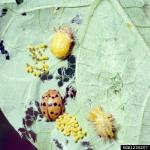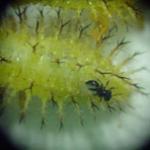Mexican Bean Beetle
Epilachna varivestis
While they are not a pest on every farm, some farms report significant damage from Mexican Bean Beetles (MBB) and have to take action to prevent crop loss. They may be pests on snap beans, lima beans, and, more recently, soybeans. Soybeans are a less suitable host for development and survival compared to snap beans, but crop damage can ocur on both crops. Using biological control can reduce the need for insecticides; see below for details.
Identification:
Mexican bean beetle adults are coppery brown with black spots. They look very much like large ladybeetles and in fact are closely related – but unlike lady beetles they feed on leaves, not other insects. Shortly after adults arrive in a bean field, they lay yellow-orange egg masses in clusters of 40 to 50 on the underside of bean leaves. These hatch into bright yellow, spiny, oval larvae, which feed, molt several times as they grow, and pupate on the underside of leaves. Feeding damage from adults and larvae can reduce yield and injure pods if numbers are high.
Life Cycle:
Mexican bean beetles overwinter as adults, and seek out beans for feeding and reproduction. Overwintering adults colonize beans in June. There are 2-3 generations per season, usually increasing in numbers with each generation. The complete life cycle takes 30-40 days in the summer months, but closer to 60 days when temperatures are cooler.
Crop Injury:
Adults and larvae feed primarily on leaves, but when numbers are high they will also damage pods. Feeding occurs on the underside of leaves, but causes death of leaf tissue in a lace-like pattern. Feeding damage over 10-20% can cause yield loss. Plants are most sensitive in the pod fill stage.
Monitoring & Thresholds:
Search plants, especially the underside of leaves, for adults, eggs, larvae and feeding damage.
Cultural Controls:
- Promptly destroy crop residues after harvest to reduce overwintering populations.
- Maintain wide, clean headlands and brushless wood edges.
- Avoid sequential plantings in close proximity.
- Row covers can be used to exclude beetles until harvest, or for as long as it is practical.
- Reflective metallic and white plastic mulches have been shown to significantly reduce beetle densities and feeding damage relative to black plastic or bare ground.
Biological Controls:
If Mexican bean beetles have historically been a problem on your farm, you will very likely see them again this year. Using biological control can reduce the need for insecticides.
Pediobius faveolatus
Pediobius faveolatus is a commercially available biological control agent for Mexican bean beetle and has a good track record in the mid-Atlantic states and among New England growers who have tried it. (Pediobius is pronounced “pee-dee-OH-bee-us”). It is mass-reared and sold by the New Jersey Dept of Agriculture and is also available from other beneficial insect suppliers. This small (1-3 mm), non-stinging parasitic wasp lays its eggs in Mexican bean beetle larvae. Wasp larvae feed inside the MBB larva, kill it, and pupate inside it, forming a brownish case or ‘mummy’. About twenty five adult wasps emerge from one mummy. Adult wasps will emerge from mummies within 2-3 days of receipt. The parasitoids are shipped to farms as mummies or as adults.
Pediobius is well suited to our succession-planted snap bean crops. The first bean planting serves as a ‘nurse crop’ to establish the population of Pediobius that will be hard at work in successive plantings all summer. Control continues and in fact gets better as the season progresses and successive generations of the wasp emerge and search out new bean beetle larvae. Planning 2-3 releases at 7-10 day intervals will help ensure good timing and coverage on several plantings. After a release in the first planting, it is advisable to leave that planting intact for a while, until the new generation of wasps has emerged from their mummies.
As with any biological control, make releases as soon as the pest is present, not after it has built up to damaging numbers. The New Jersey Dept of Agriculture Beneficial Insect Rearing Laboratory recommends two releases, two weeks in a row, coinciding with the beginning of Mexican bean beetle egg hatch. Wasps will lay their eggs in larvae of any size, but it is best to target the newly-hatched young MBB larvae. This will give control before damage has been done. Thus, timing is important. Watch for eggs and time the shipment for the first hatch of eggs into larvae. If in doubt about the timing of the hatch, release as soon as you see the eggs – if you wait for the larvae you may be playing catch-up. The release rate should be at least 2000 adult wasps per field for less than an acre, or 3,000 per acre for fields of one acre or more. Mummies are frequently shipped in screen bags. Simply secure to the underside of a bean plant. IPM Laboratories recommends 160 mummies/A, split between 2 releases for light infestations, 640 mummies/A, split between 2 releases for heavy infestations and for the home garden, a minimum of 10 - 15 mummies.
Like beans, Pediobius wasps are killed by frost so annual releases are necessary. Most fungicides will not be harmful. Many insecticides will be harmful.
Plan ahead by contacting a supplier to inform them of your acreage and expected release dates (based on what you’re seeing when scouting).
Contact information for New Jersey State Dept of Agriculture: Philip Alampi Beneficial Insect Rearing Lab, (609) 530-4192. You’ll also get advice on how to use the wasps from this office.
Pediobius is also available from the following suppliers:
- IPM Laboratories, NY, 315-497-2063. Contact to check availability.
- ARBICO Organics, 800 -827-2847. Order online; orders ship on Wednesdays ONLY, minimum 7 day processing
Chemical Controls:
Treatment with an insecticide may be warranted to prevent economic losses. A suggested treatment threshold is >20% defoliation during pre-bloom or 10% during pod formation. Several conventional and organic insecticides are labeled for use against MBB, including several products that also effectively control potato leafhopper, which is also a major pest of beans and which we’re seeing now in bean fields. Be sure to get coverage of lower leaf surfaces. Kaolin clay (Surround) may be used on seedlings and young plants to deter feeding and egg laying. For more information on chemical control options, see the New England Vegetable Management Guide.
Chemical controls for MBB and potato leafhopper could have harmful effects on Pediobius, especially on adult wasps. If releasing Pediobius, avoid sprays shortly before or after releases; apply treatments to a succession planting 5 days before release.
Crops that are affected by this insect:
The Center for Agriculture, Food and the Environment and UMass Extension are equal opportunity providers and employers, United States Department of Agriculture cooperating. Contact your local Extension office for information on disability accommodations. Contact the State Center Director’s Office if you have concerns related to discrimination, 413-545-4800 or see ag.umass.edu/civil-rights-information.


